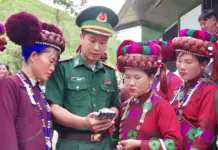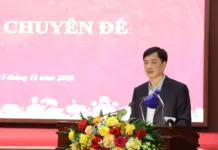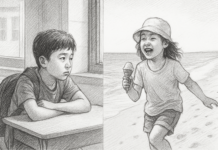-
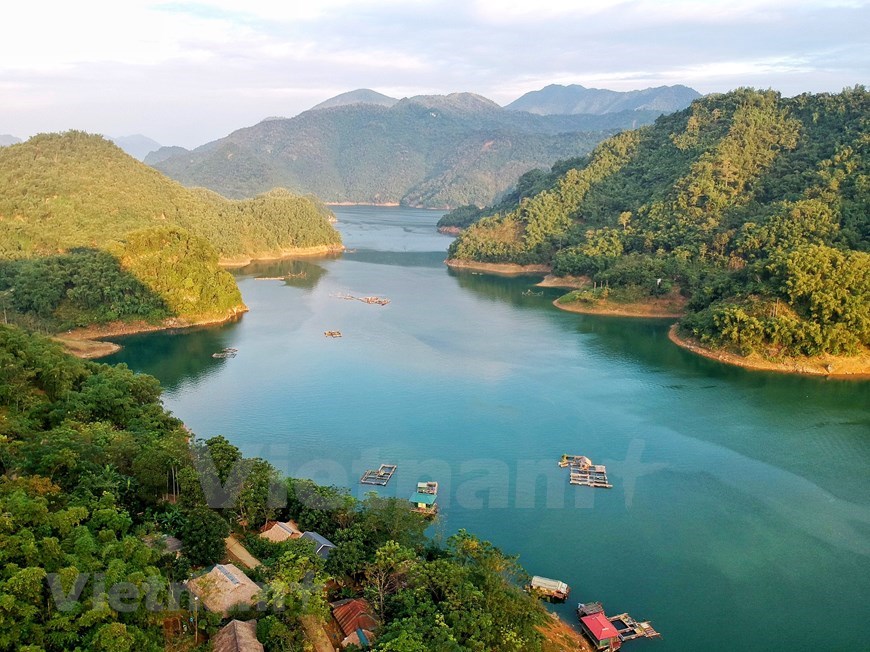
Da Bia village is among many beautiful tourist destinations in the northern mountainous province of Hoa Binh, including Thung Nai, Tu Son Waterfall, Mai Chau, Thien Long and Thac Bo Caves, Thang Thien Waterfall, Lung Van Mount, Kim Boi Hot Spring, Hoa Binh Hydropower Plant, Thung Khe Pass, Ba Khan, and Da Bac. Lying on the shores of Hoa Binh Reservoir, the largest man-made lake in Vietnam, Da Bia village boasts beautiful scenery. The ethnic minority village is dubbed as a perfect place for travellers longing to explore untouched wild nature and authentic indigenous history and culture. (Photo: VietnamPlus)
-

A panoramic view of Da Bia village which lies on the bank of Hoa Binh Reservoir, Vietnam’s largest man-made reservoir. Formed during the construction of Hoa Binh Hydropower Plant, the reservoir is renowned for magnificent primitive mountain landscapes and diverse ecosystems. With 47 islets scattered on the 100 km-long water surface, and peaceful villages of Muong ethnic group stretching along its banks, Hoa Binh Reservoir has been emerging as a very popular destination for holidaymakers. The area has been seeing community-based tourism booming over the last several years, providing visitors with various exciting experiences of its untouched nature and traditional ethnic minority cultures. (Photo: VietnamPlus)
-

It only takes a two-day weekend to explore Muong culture in Da Bia village. The tour offers visitors different levels of excitement, from unwinding boat trip, adventurous hill hiking to unique taste of traditional food made by ethnic minority people and relaxing view of old stilt houses lying under the shade of trees. Located in the far-flung commune of Tien Phong, Da Bac district, Da Bia village can be reached by road or waterway. By waterway, visitors can enjoy the amazing scenery of Hoa Binh Reservoir known for crystal-clear water and green islands. Travelling by road, visitors will embark on an adventurous journey through weaving steep mountain roads with lots of trees and flowers on the sides. (Photo: VietnamPlus)
-
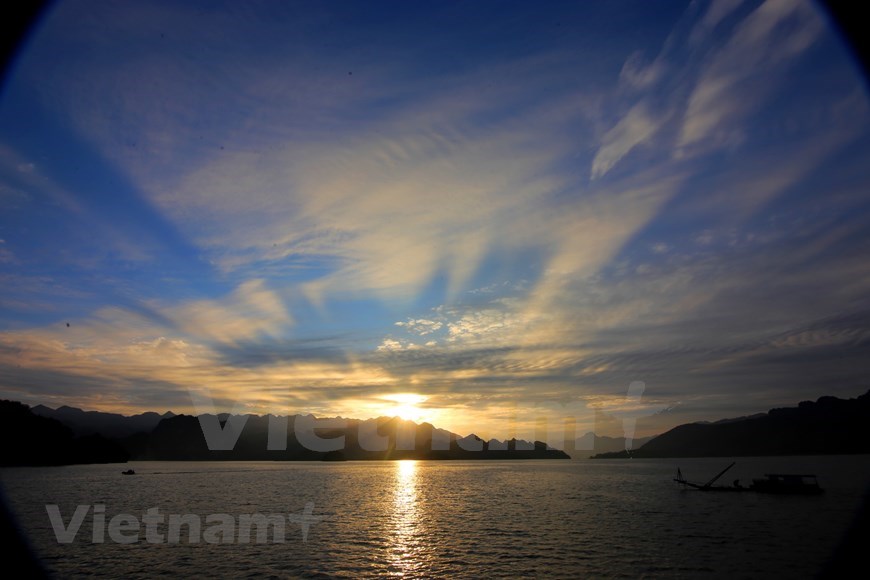
Sunset at Thung Nai wharf. It takes about an hour and a half to reach Da Bia village from Thung Nai wharf by boat. Located 110 km from Hanoi, Thung Nai is a large valley surrounded by forests and mountains which are home to a large number of deer. The scenery here is so marvelous that Thung Nai is dubbed as a miniature of Ha Long Bay. Thung Nai is most crowded in the spring because that’s the best time to admire its beauty. Visitors can also explore villages of the Muong ethnic minority, like Da Bia, as well as Thac Bo cave and temple and Thac Bo market. (Photo: VietnamPlus)
-
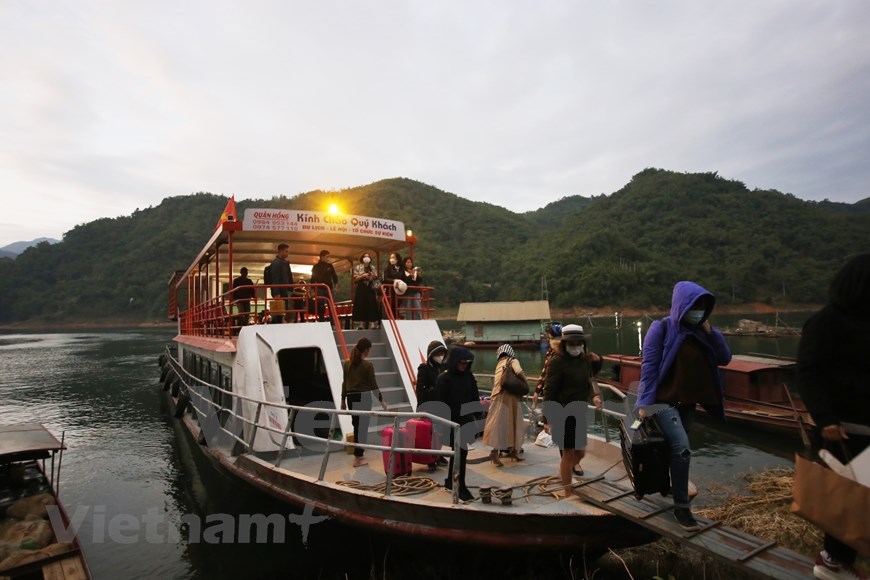
Passengers complete a boat trip through Hoa Binh Reservoir before landing in Da Bia village. The ethnic minority village will form part of Hoa Binh Reservoir national tourist area, which is under development until 2035 in accordance with the Prime Minister’s decision dated March 25, 2021. The national tourist area will cover a total area of 52,200 hectares across Hoa Binh city, the provincial capital, and parts of the four districts of Da Bac, Cao Phong, Tan Lac and Mai Chau. It is expected to house some 130,000 – 145,000 residents and welcome about 2.5 – 3 million visitors annually by 2035. (Photo: VietnamPlus)
-
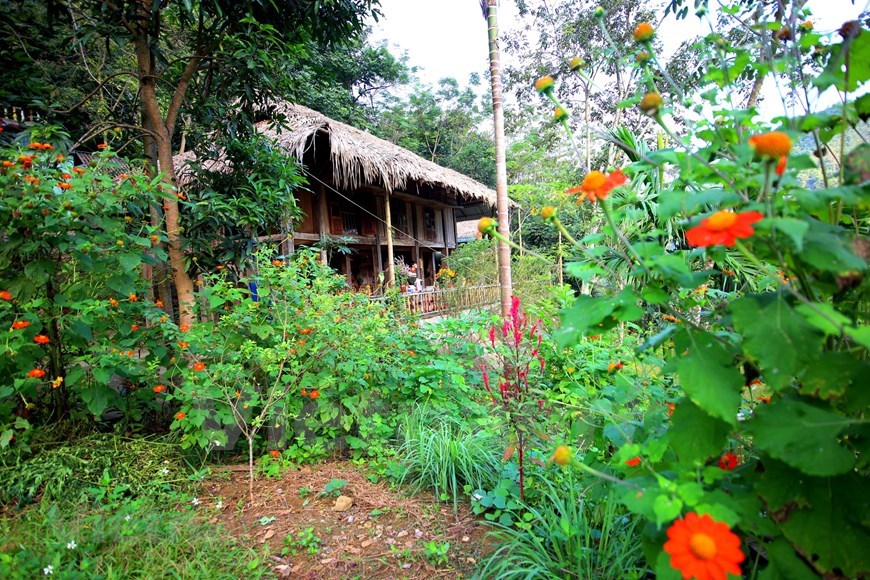
A stilt house used as a homestay in Da Bia Village, surrounded by lots of trees and flowering plants. The village is located in the far-flung commune of Tien Phong, Da Bac district. Just about 100km or three hours’ drive from Hanoi, Da Bac district is one place where a community-based approach to tourism is succeeding. The landscape here is mountainous, with the aqua-marine Da River slicing next to the district. Because of its proximity to Hanoi, the district is one of the favourite spots for a quick getaway from the city. Some foreign visitors even refered Da Bac as one of the most authentic, rewarding tourism experiences on offer in Northern Vietnam. (Photo: VietnamPlus)
-
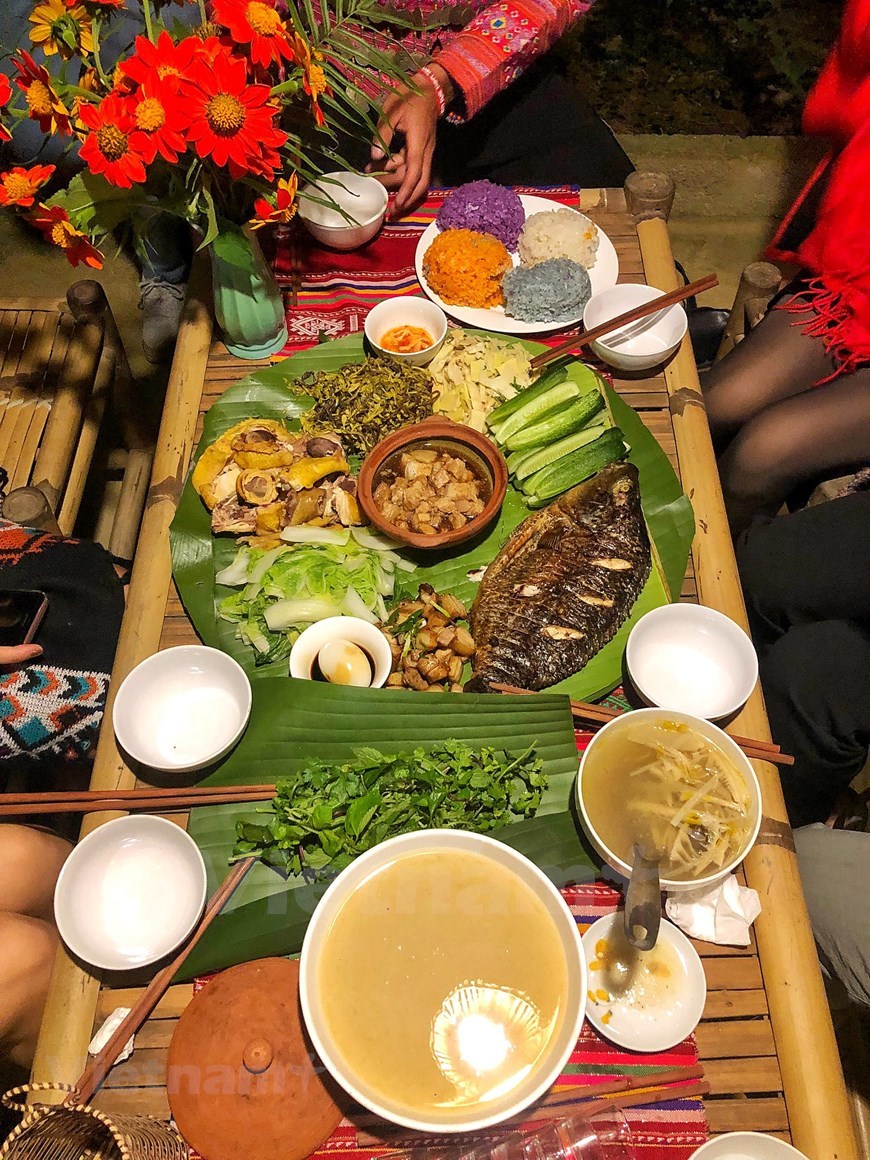
Da Bia is a Muong Ao Ta village located on the edge of the Da River. The village keeps nature almost untouched with the clear and cool air of the primeval forest, and the tranquility of a mountain countryside where the only sounds one can hear are birdsongs. In Da Bia, more than half the 39 households are involved in community-based tourism, most of whom were farmers before they got involved in this type of services. A local fishing coop provides the homestays with fresh aquatic products. There’s a cooking group to help with preparing meals, and a kayaking group that rents out equipment to tourists. (Photo: VietnamPlus)
-
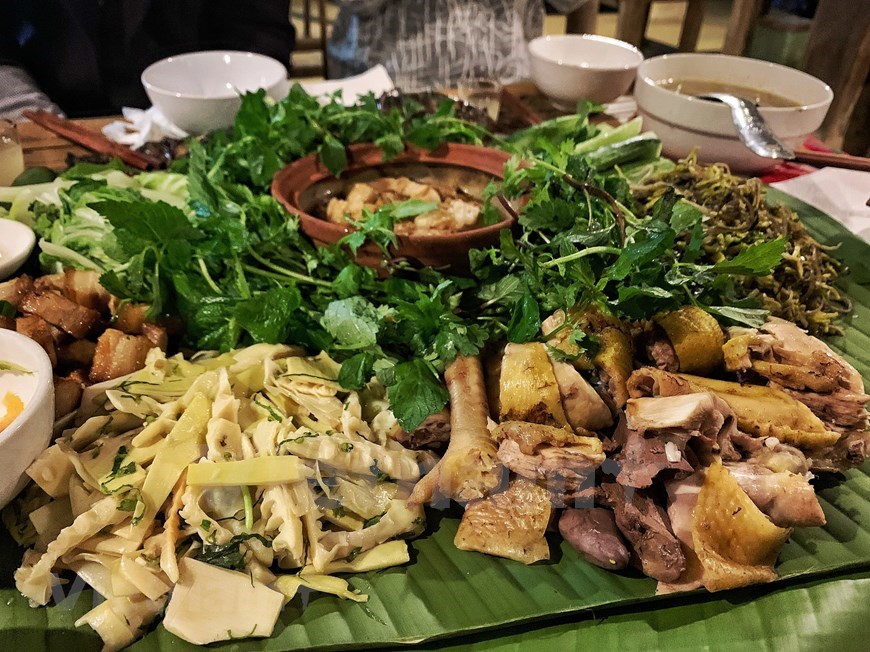
Simple but delicious food of the Muong Ao Ta is among the irresistible charms to visitors to Da Bia. Meals are prepared by homestay owners and other members of the community using fresh, seasonal and locally grown ingredients. Lunch and dinner are served ‘family style’ – big shared plates set in the centre of the table. These meals usually included pork, chicken and fish, plus at least three different tofu and vegetable dishes. Tourism creates jobs for women here in the community and contributes to gender equality. The chance to introduce visitors to traditional Muong and Dao cultures encourages people to place new value on certain traditions, including ceremonial dancing, indigo dyeing and embroidery. (Photo: VietnamPlus)
-
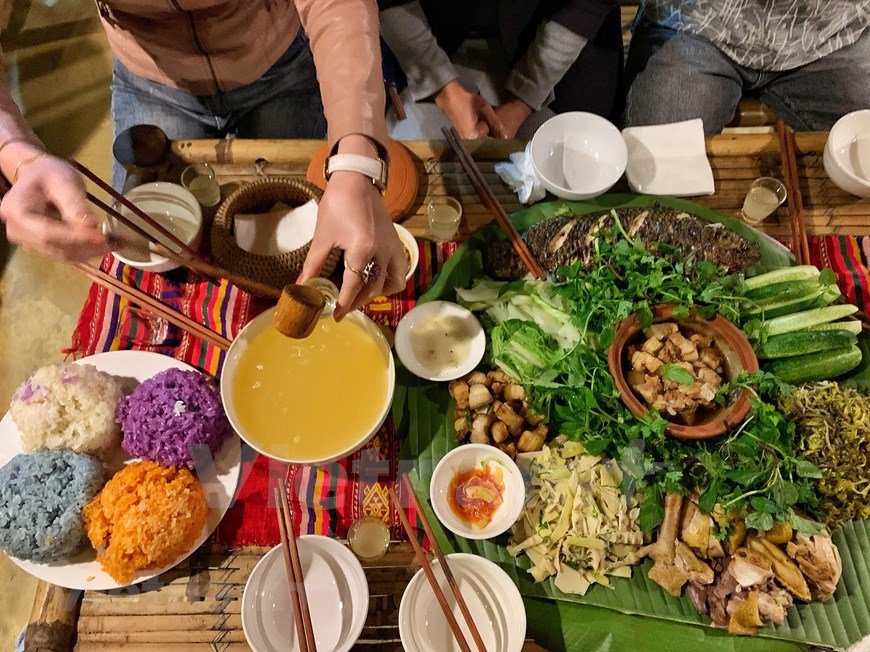
In Da Bia village, more than half the 39 households are involved in community-based tourism, most of who lived off farming before they got involved in this type of services. A local fishing coop provides the homestays with fresh aquatic products. Meals are prepared by homestay owners and other members of the community using fresh, seasonal and locally grown ingredients. Lunch and dinner are served in ‘family style’ – big shared plates set in the centre of the table. These traditional meals usually included pork, chicken and fish, plus at least three different tofu and vegetable dishes, like young bamboo shoots. (Photo: VietnamPlus)
-
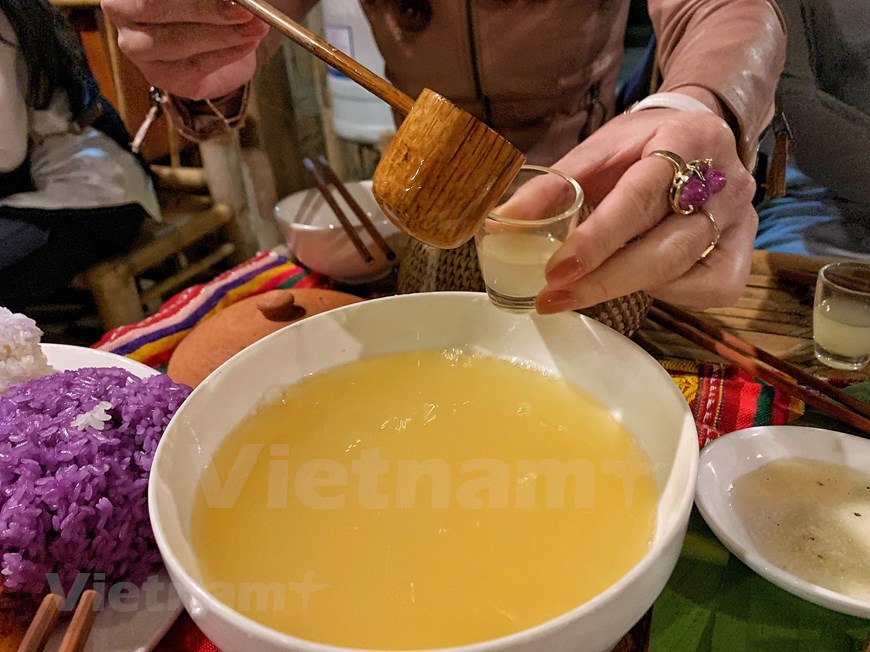
Drinking is also a huge part of Da Bia village’s culture, like in many other parts of Vietnam. A meal cannot go without a drink when a family here welcomes guests. Homestay owners here glowed as they talked about the pride they have in their culture and the joy that comes with sharing it with other people. Tourism creates inter-generational opportunities in the community and allows families to stay together — whereas before it was more common for children to move to the city, now they can stay, learn, and eventually inherit a family business. The chance to learn from and exchange knowledge with tourists was something that came up again and again, even when language is a barrier. (Photo: VietnamPlus)
-
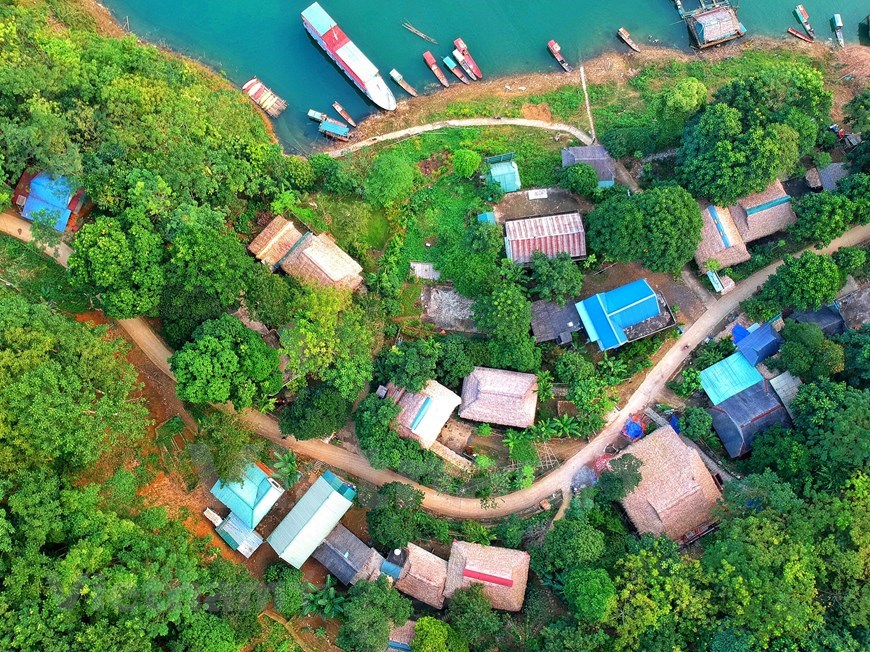
A panoramic view of Da Bia village which lies on the bank of Hoa Binh Reservoir, Vietnam’s largest man-made reservoir. Formed during the construction of Hoa Binh Hydropower Plant, the reservoir is renowned for magnificent primitive mountain landscapes and diverse ecosystems. With 47 islets scattered on the 100 km-long water surface, and peaceful villages of Muong ethnic group stretching along its banks, Hoa Binh Reservoir has been emerging as a very popular destination for holidaymakers. The area has been seeing community-based tourism booming over the last several years, providing visitors with various exciting experiences of its untouched nature and traditional ethnic minority cultures. (Photo: VietnamPlus)
-
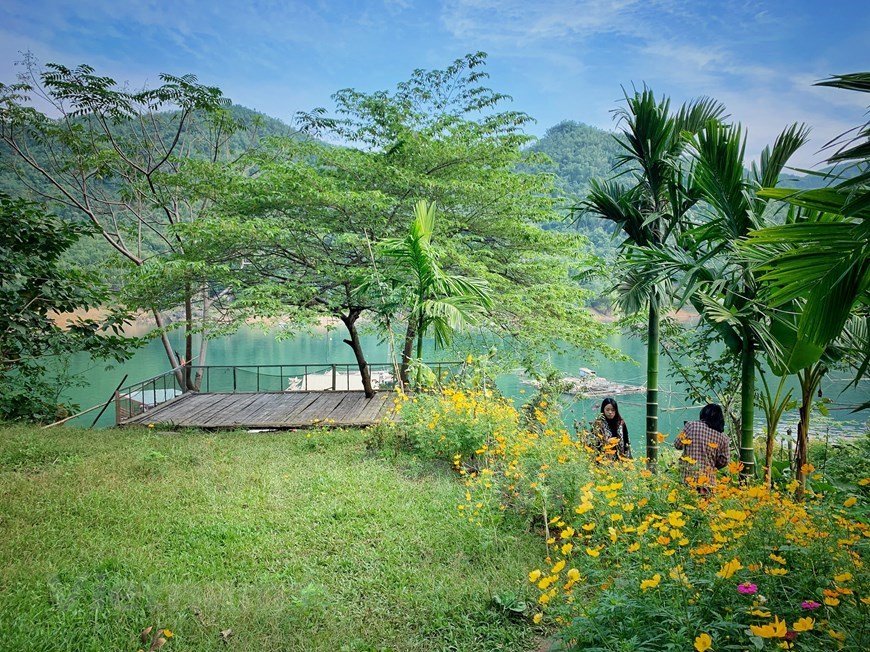
Tranquil and romantic scenery in front of Lake View, one of the most beautiful and popular homestays in Da Bia village. Local residents have been very positive about the effects community-based tourism has brought to their community. Homestay owners all report growth in their household income; the extra money they make is typically used to fund their children’s education, purchase new farming equipment, and upgrade the home. The chance to introduce visitors to traditional Muong and Dao cultures encourages people to place new value on certain traditions, including ceremonial dancing, indigo dyeing and embroidery. Tourism also creates jobs for women in the community and contributes to gender equality. (Photo: VietnamPlus)
-
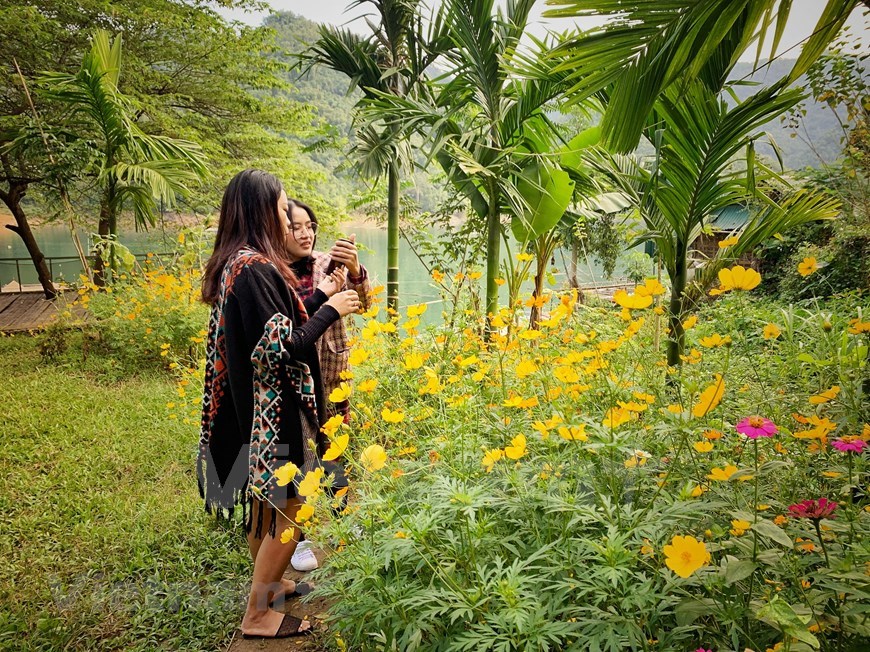
Da Bia village keeps nature almost untouched with the clear and cool air of the primeval forest, and the tranquility of a mountain countryside where the only sounds one can hear are birdsongs. It only takes a two-day weekend to explore Muong culture in the Village. The tour offers visitors different levels of excitement, from unwinding boat trip, adventurous hill hiking to unique taste of traditional food made by ethnic minority people and relaxing view of old stilt houses lying under the shade of trees. The village is dubbed as a perfect place for travelers longing to explore untouched wild nature and authentic indigenous history and culture. (Photo: VietnamPlus)
-
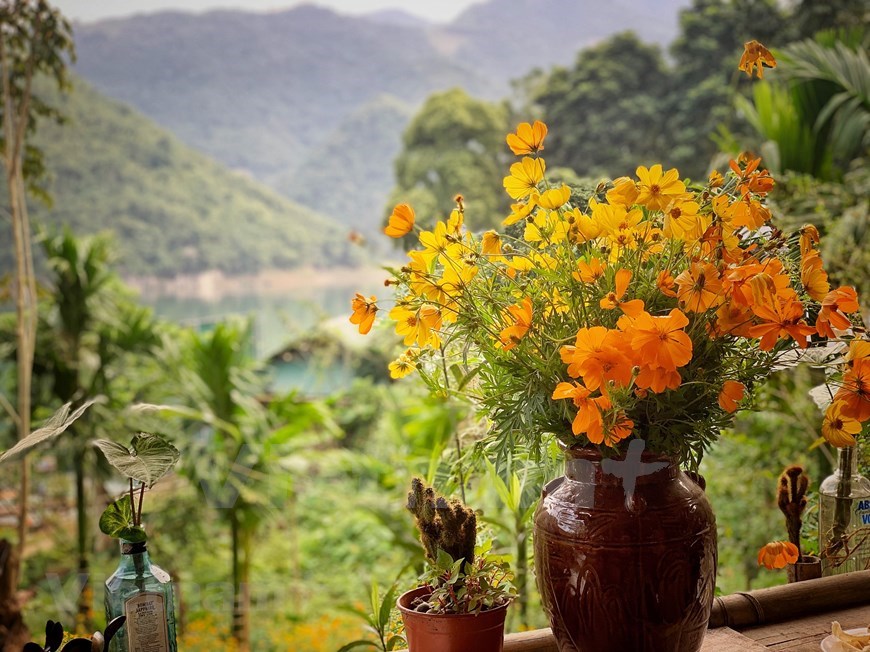
Lake View, one of the most popular homestays in Da Bia village, is surrounded by lots of trees and flowers. The village is among many beautiful tourist destinations in the northern mountainous province of Hoa Binh, such as Thung Nai, Tu Son Waterfall, Mai Chau, Thien Long and Thac Bo Caves, Thang Thien Waterfall, Lung Van Mount, Kim Boi Hot Spring, Hoa Binh Hydropower Plant, Thung Khe Pass, Ba Khan, and Da Bac. Local residents have been very positive about the effects community-based tourism has brought to their community. Homestay owners all report growth in their household income. (Photo: VietnamPlus)
-
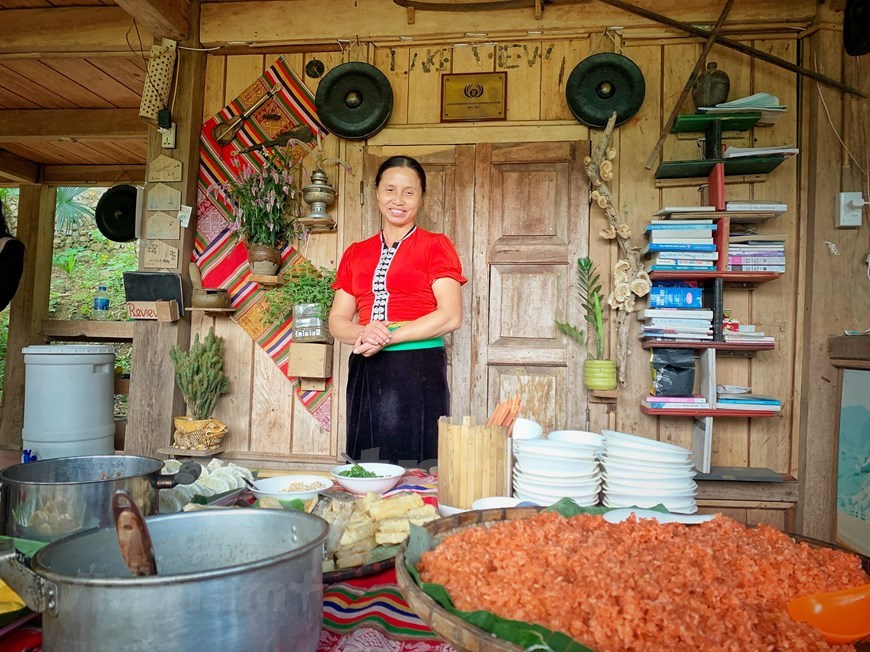
Dinh Thi Yeu, owner of Lake View Homestay, is about to serve her guests with a number of traditional breakfast dishes which include sticky rice, “Uoi” cake and fish porridge. In the Muong language, Uoi cake is pronounced “peeng uoi” or the husband & wife cake. The main ingredients to make the cake include sticky rice, lentils, peanuts, sesame, and leaves (in many places banana leaves are used). Normally, the delicious and sticky Uoi cakes need the delicious sticky rice. Before wrapping, the sticky rice is washed thoroughly, soaked overnight until the sticky rice is soft and then ground into a fine powder. (Photo: VietnamPlus)
-

Visitors are enjoying traditional breakfast of ethnic minority people at Lake View Homestay. The main ingredients to make Uoi cakes include sticky rice, lentils, peanuts, sesame, and leaves (in many places banana leaves are used). Before wrapping, the sticky rice is washed thoroughly, soaked overnight until the sticky rice is soft and then ground into a fine powder. The flavor of banana leaves, bergamot leaves mixed with the flavor of the fragrant sticky rice, the fleshy kernel of green bean and meat, melting in the mouth creates an unforgettable impression. The cake has become a precious gift for the guests when coming to Da Bia. (Photo: VietnamPlus)
-

Porridge is made from fish caught in Da River. Hoa Binh is blessed with the Da River a rich source of aquatic species in the northwestern region. The fish in the clean river are delicious with various recipes. In the past, fishermen used bamboo rods and rice and sweet potato as bait, but now things have changed with the use of carbon rods, reels, and mixed bait bought from the market. It may take them all day to catch a small fish like muong (hemiculter), chay (spinibarbus caldwelli) and tilapia, but this is enough to make them feel quite happy. (Photo: VietnamPlus)
-
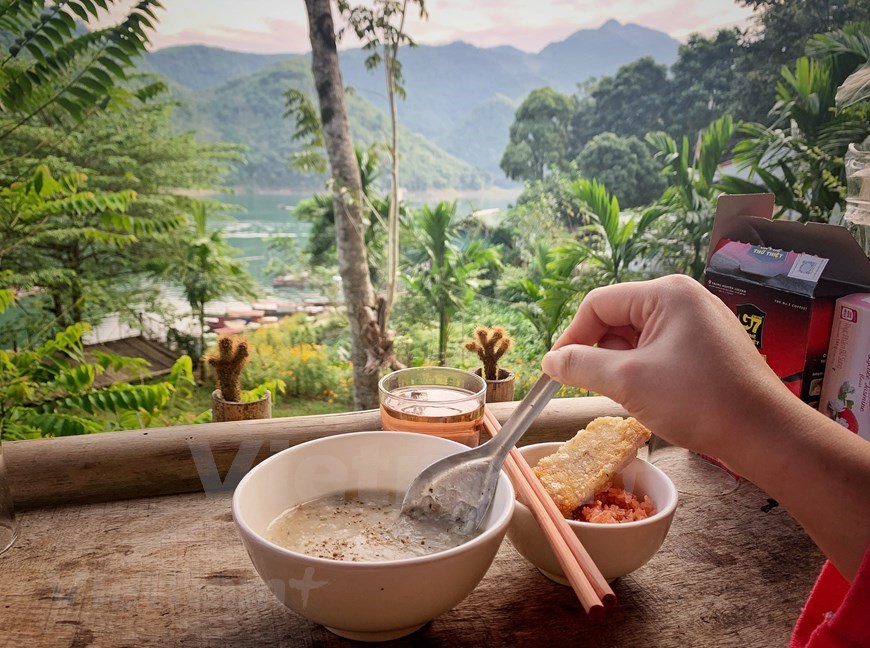
Having fish porridge while enjoying relaxing view at Lake View Homestay. Hoa Binh is blessed with the Da River – a rich source of aquatic species in the northwestern region. The fish in the clean river are delicious with various recipes. In the past, fishermen used bamboo rods and rice and sweet potato as bait, but now things have changed with the use of carbon rods, reels, and mixed bait bought from the market. It may take them all day to catch a small fish like muong (hemiculter), chay (spinibarbus caldwelli) and tilapia, but this is enough to make them feel quite happy. (Photo: VietnamPlus)
-
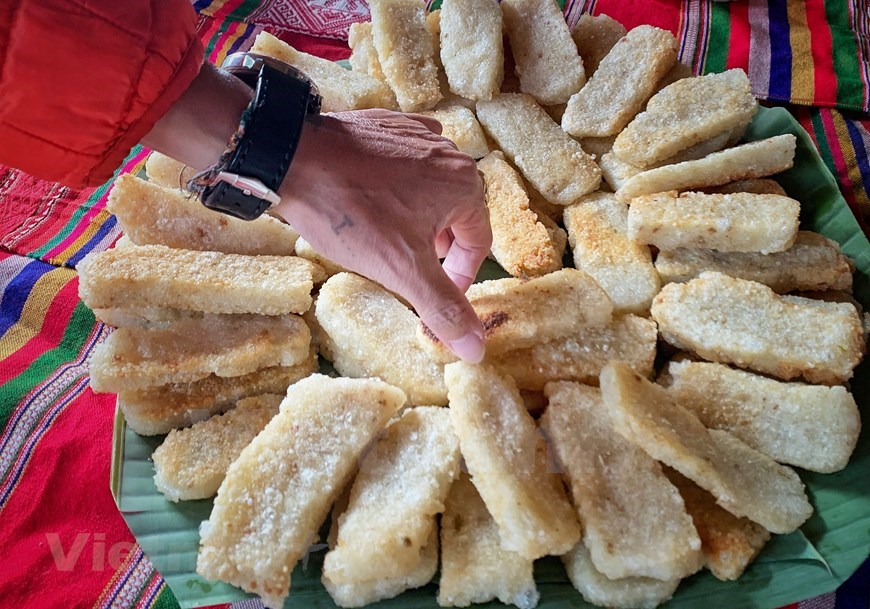
Net cake – a specialty of the Muong ethnic people in Da Bac district. Over the past years, Da Bac district has mobilised resources and designed policies to promote and attract investment to the development of tourism, especially community-based tourism. Located on the banks of Hoa Binh Lake, it is well-known for beautiful landscapes. In recent years, the district has emerged as a magnet for tourism investors. Da Bac has developed many community-based tourist sites such as Ke village of Hien Luong commune, Duc Phong and Mo Hem villages in Tien Phong commune, and Sung village in Cao Son commune. These areas also boast unique cultural identities of local ethnic minority groups. (Photo: VietnamPlus
-

Travellers have breakfast which includes speciality dishes of the Muong people. As part of its tourism development strategy, in 2017, the People’s Committee of Da Bac district built a plan to boost the tourism sector by 2020, with a vision to 2030. The plan’s objectives include specifying orientations for tourism planning and development and turning Da Bac into an attractive tourist destination of the province, thus helping to create jobs, improve local residents’ income, step up economic restructuring, and contribute to the State budget. With its potential and efforts to develop tourism, Da Bac district has high hope to enjoy strong growth in tourism. (Photo: VietnamPlus)
-
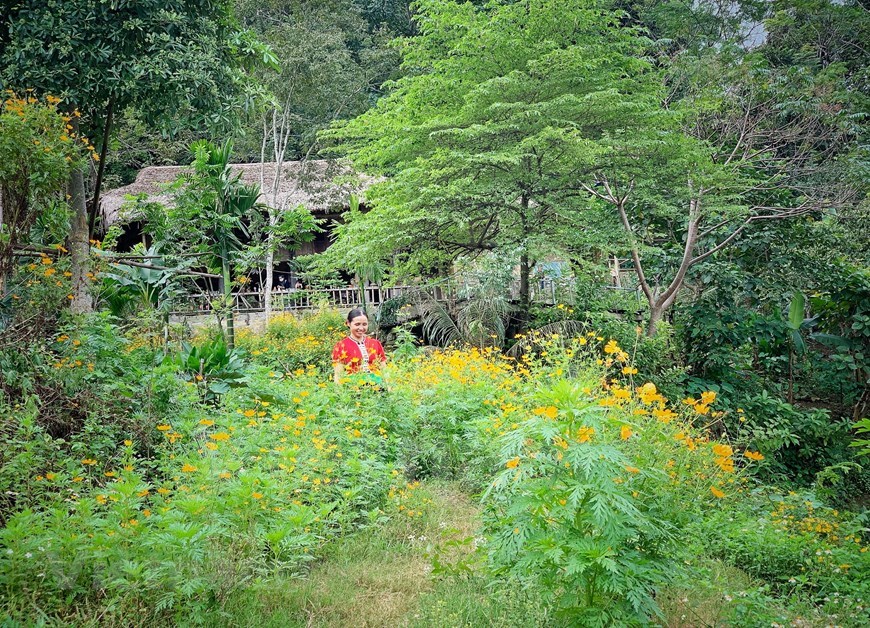
Dinh Thi Yeu, a local resident and also a tour guide, assists visitors to explore Da Bia village in Tien Phong commune, Da Bac district. Many hamlets and villages in the vicinity of Hoa Binh Reservoir such as Ke village (Hien Luong commune), Duc Phong village (Tien Phong commune), and Sung hamlet (Cao Son commune) have made their mark on the tourist map, becoming tourist destinations and attracting a lot of domestic and foreign visitors. Bui Van Luyen, Secretary of the Da Bac Party Committee, said local authorities are working to turn the Hoa Binh Reservoir area into a key tourist destination of Hoa Binh province. As many projects are being rolled out and infrastructure upgraded, Da Bac is tapping into its tourism potential. (Photo: VietnamPlus)
-
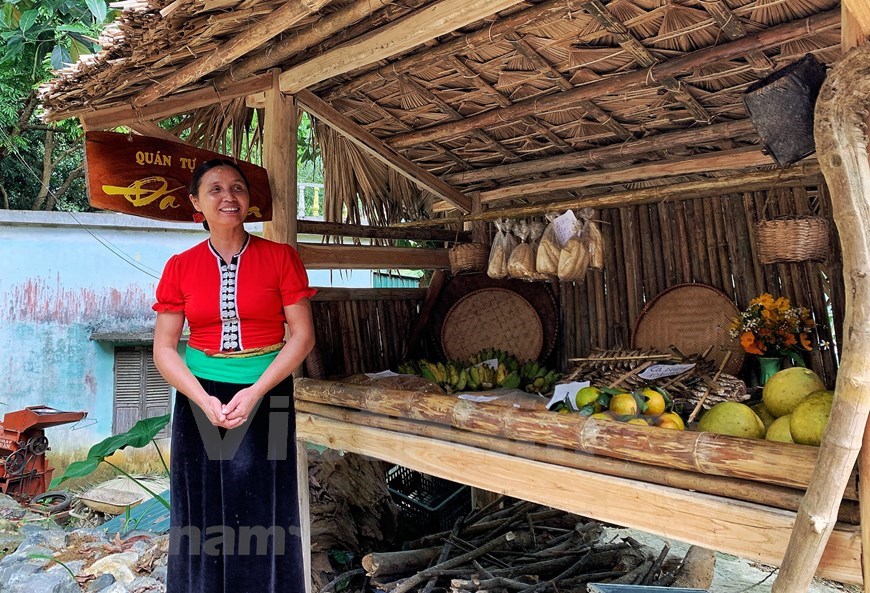
The ‘self-awareness’ shop is a unique type of stores in Da Bia village. Yeu said this model came into being in the 1960s and was fell into oblivion for a period of time. It has just been revived in recent years. Da Bac district possesses pristine and beautiful nature with rich cultural identity of different ethnic groups. It has been identified as a key area for tourism development in Hoa Binh province. In recent years, the district has moved to support organisations and individuals to participate in developing different types of tourism such as community-based tourism, ecological tourism, and experiential tourism. Tourism in this upland district has prospered over the past years, with the number of visitors and tourism revenue increasing annually. (Photo: VietnamPlus)
-
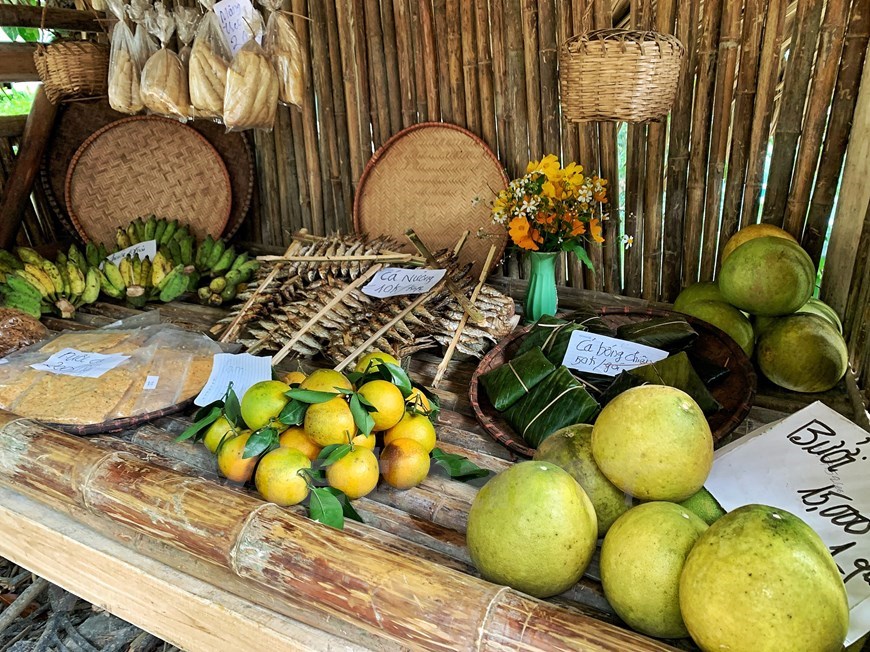
At the ‘self-awareness’ shops, sellers only need to put their items and price labels on shelves and then leave. Buyers will choose and weigh products by themselves and put money into a basket at the shops. Hoa Binh province is moving to stimulate travel demand in the new context. At a tourism promotion conference on October 18, the provincial People’s Committee announced that Hoa Binh is at Pandemic Level No. 1 – the lowest level, which is a favourable condition for recovering socio-economic activities, especially tourism. The tourism industry is thriving after 61 years, and it has contributed tremendously to the economic growth of this locality. (Photo: VietnamPlus)
-

A buyer selects items placed at a ‘self-awareness’ shop. Hoa Binh province is home to a number of tourist attractions. Among them, Hoa Binh Lake, dubbed “Ha Long Bay on the mountain”, has proved to be a magnet for visitors from far and wide. Local authorities are working to turn this place into a national tourism area. Accordingly, they have been making investment to develop local tourism infrastructure, introducing the Hoa Binh Lake tourism area on the media, and include this site in tours of destinations in northern Vietnam. In recent years, the number of tourist arrivals and tourism revenue in Hoa Binh have been on the rise, at an average annual growth rate of over 10 percent. (Photo: VietnamPlus)
-
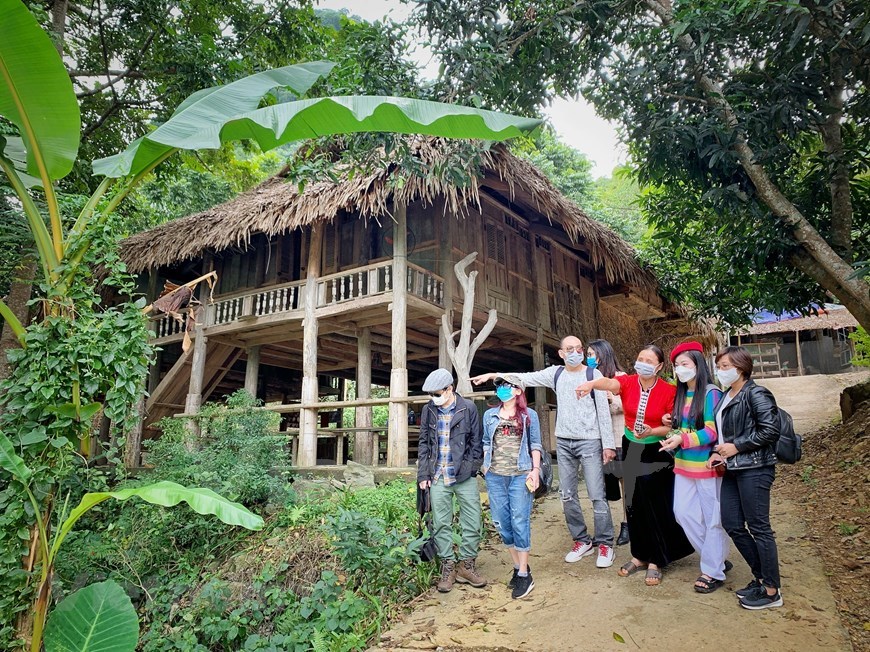
Local residents serve as tour guides helping travelles explore Da Bia village. Da Bia is the most remote place of Tien Phong commune, Da Bac district. To reach this village, it takes visitors about one and a half hours going by boat from Thung Nai wharf of Cao Phong district. As of late 2020, Da Bac district was home to 18 tourism projects, five of which are located in lakeside areas, including the Robinson natural tourist area, the Mai Da resort in Tien Phong commune, the Vay Nua ecological resort in Vay Nua commune, and the afforestation and eco-tourism project in Hien Luong commune. (Photo: VietnamPlus)
-
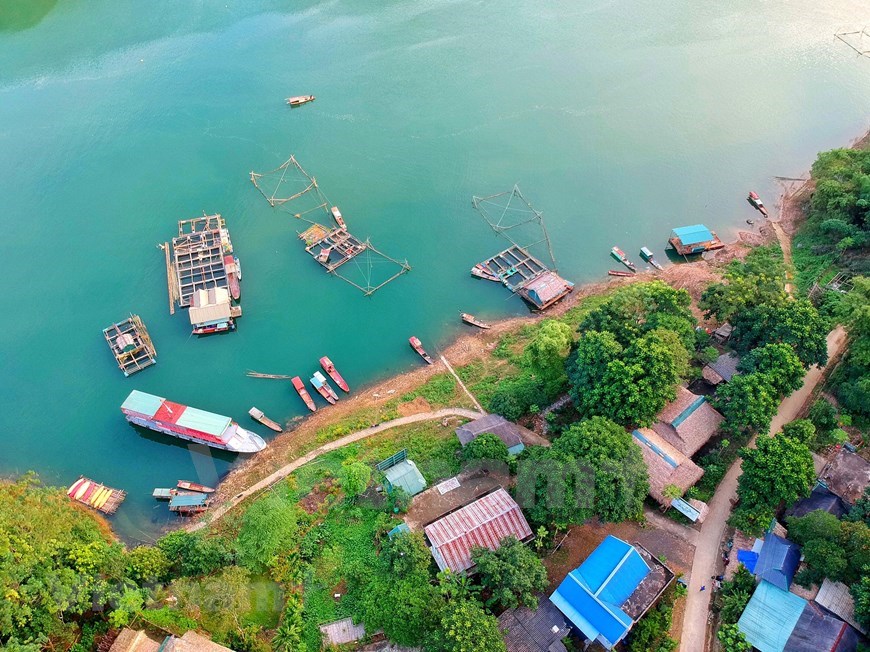
Da Bia is a riverside village which now has relatively favourale conditions for economic activities compared to the past. About five – six years ago, it was almost inaccessible due to poor road infrastructure, and local residents were almost isolated from the outside world. At present, concrete roads have made it easier for people to reach this hamlet. Nguyen Van Toan, head of the Da Bac district culture and sports office, said on August 1, 2016, the Prime Minister issued Decision No.1528/QD-TTg on a master plan on the development of Hoa Binh Lake into a national tourist site in Hoa Binh province by 2030. (Photo: VietnamPlus)
-
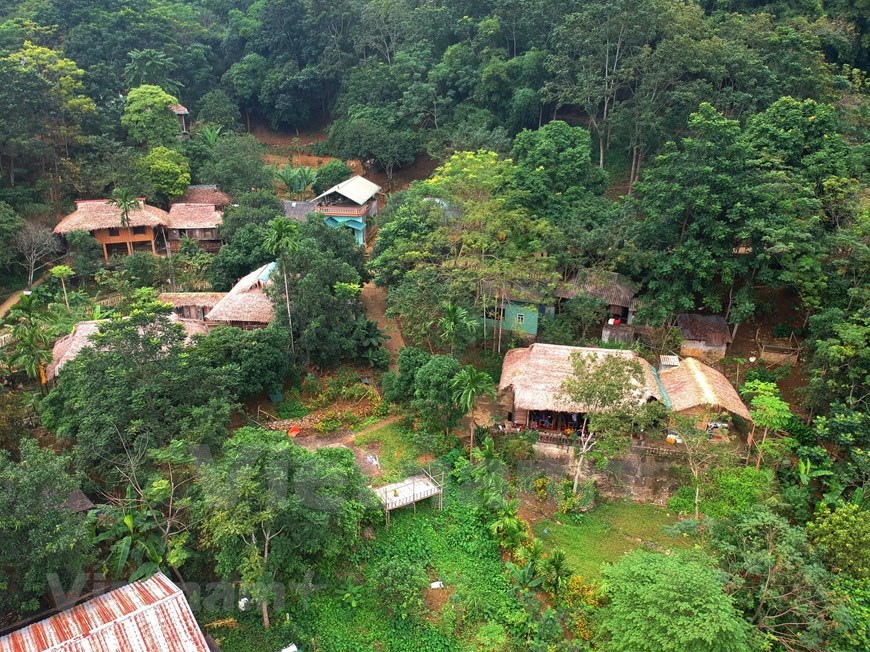
Community-based tourism has given a breath of fresh air to this most remote place of Da Bac district. The Action on Poverty, the new name of the Australian Foundation for the Peoples of Asia and the Pacific Limited – a non-governmental organisation of Australia, is the one help local Muong ethnic people to develop community-based tourism. Thanks to this organisation’s support, areas of community-based tourism have taken shape in the communes of Hien Luong, Cao Son and Tien Phong. Between 2015 and 2020, the provincial and district budgets, along with national target programmes, provided hundreds of billions of VND for developing tourism infrastructure in eight communes, including the five lakeside communes of Cao Son, Hien Luong, Vay Nua, Tien Phong and Dong Ruong. (Photo: VietnamPlus)
-
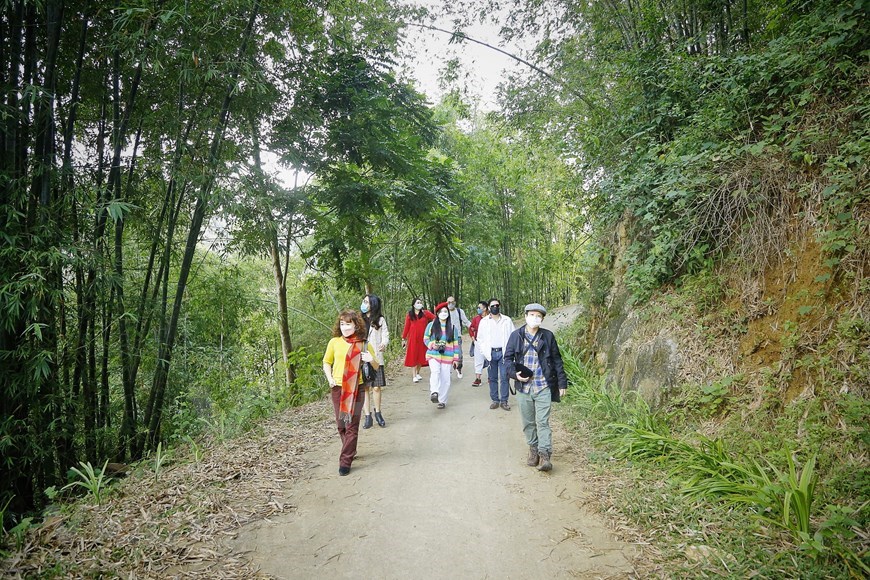
After six years, community-based tourism in Da Bac has been thriving, attracting a large number of domestic and foreign visitors to this district in the pre-pandemic period. To boost tourism in the district and its lakeside areas in particular, Da Bac has worked to improve the quality of new tourism products and offer all possible support for businesses to survey and invest in tourism. At the same time, it has popularised local festivals and destinations on the mass and social media and introduced tourism potential to domestic and foreign investors. Besides, the district has called on locals to uphold cultural identity and develop tourism in tandem with preserving natural landscapes, adopting sustainable tourism practices, creating new tourism products. (Photo: VietnamPlus)
-

Coming to Da Bac, travellers can have beautiful photos for themselves thanks to magnificent and poetic mountain landscapes here. From November 9 to 11, representatives from the Vietnam Tourism Association (VITA), the Vietnam Society of Travel Agents (VISTA), the provincial Tourism Association, travel firms in Hanoi, and press agencies joined a famtrip to the Hoa Binh Lake Tourism Area in Hoa Binh province. Da Bia village in Tien Phong commune was among the destinations in their tour. Through the trip, representatives from travel agencies highly valued tourism products of the Hoa Binh Lake tourism area, saying that they plan to design and include those into their tours in the coming time. (Photo: VietnamPlus)
-
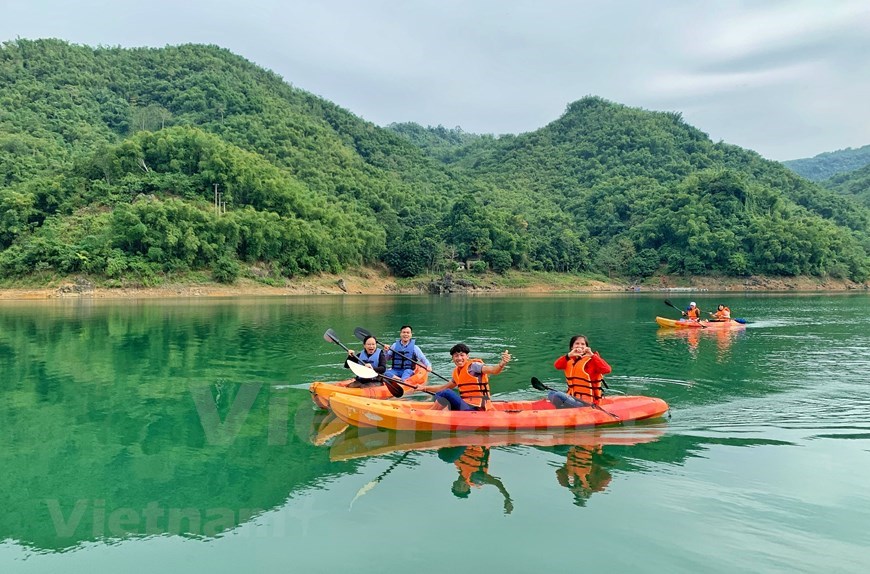
Tourists go kayaking on Hoa Binh Lake. In addition to support from provincial authorities, households involved in community-based tourism in the Hoa Binh Lake tourist area have received assistance from donors to upgrade and renovate facilities. An example is a community-based tourism project in Da Bac district that got financial and technical support from Action on Poverty, a non-governmental organisation of Australia. In particular, participating households have been provided with interest-free loans to renovate their houses and buying necessary equipment. Local authorities have also opened training courses for locals. The Hoa Binh Lake tourist area currently has about 300 tourist boats, 107 accommodation establishments, including 14 hotels, 32 motels and 61 community motels, creating jobs for about 1,200 people. (Photo: VietnamPlus)
-
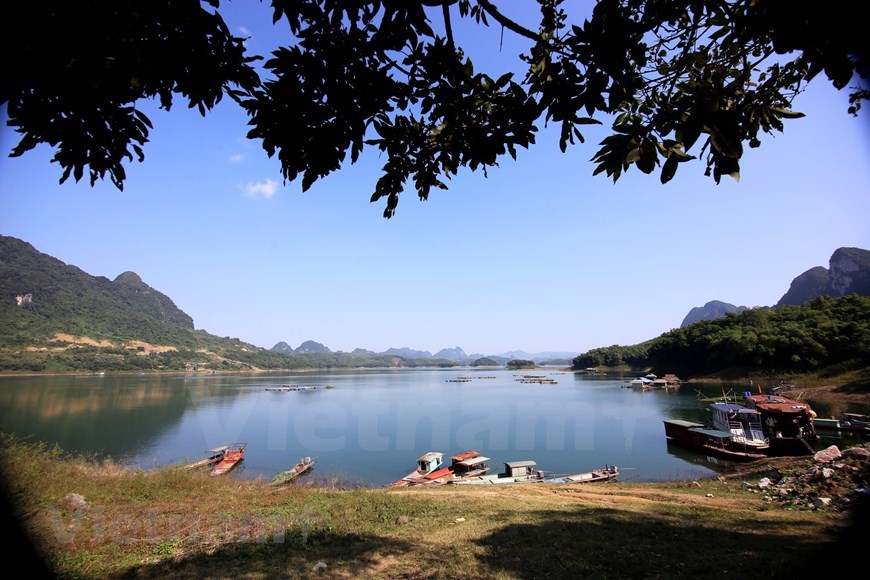
Da Bia village of Da Bac district is home to beautiful landscapes and hospitable residents. Bui Thi Niem, Director of the Hoa Binh provincial Department of Culture, Sports and Tourism, said since 2017, tourism infrastructure and facilities in the Hoa Binh Lake tourist area have received considerable investment. Hoa Binh has also worked to expand the free wifi coverage in the area to meet the information and communication needs of travel firms and tourists. Developing rural tourism has contributed to the improvement of local residents’ incomes. It is also considered a fundamental solution and a driving force for stepping up new-style rural area building in a sustainable manner. (Photo: VietnamPlus)
-
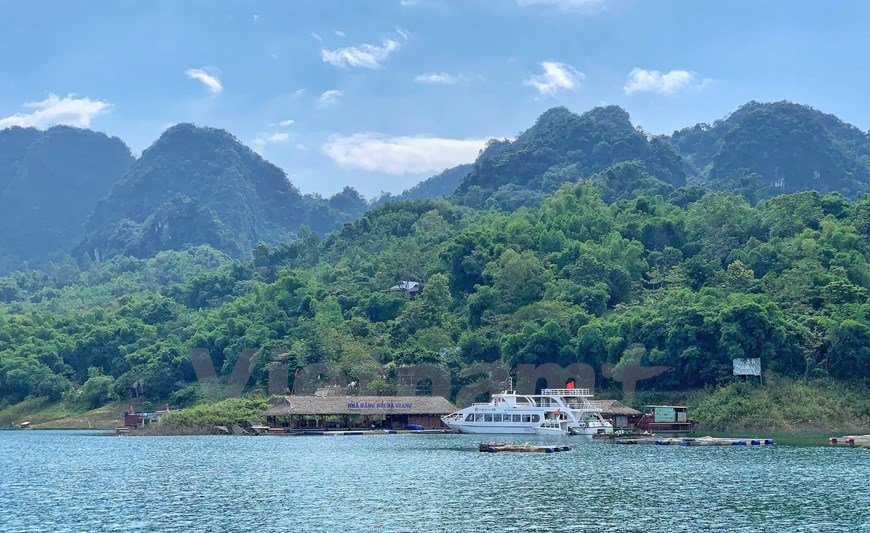
The trip continues with the next destination being Ngoi village in Ngoi Hoa commune of Tan Lac district, which is also developing community-based tourism in Hoa Binh province. Hoa Binh province is resuming tourism activities after a long hiatus caused by the fourth wave of COVID-19 outbreaks. According to Bui Xuan Truong, Deputy Director of the provincial Department of Culture, Sports and Tourism, as the pandemic has been put under control in Hoa Binh and is abating in many localities nationwide, tourist areas and attractions now begin welcoming visitors back, with focus on those who are living and working in the province and have been fully vaccinated. (Photo: VietnamPlus)
-
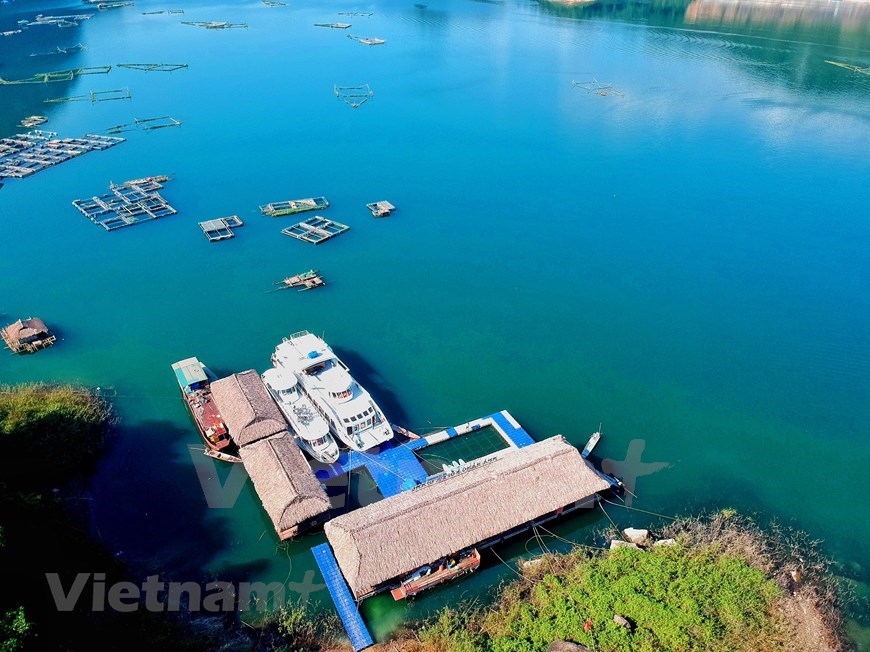
The poetic landscape around a floating restaurant on Hoa Binh Lake. Community-based tourism has been opted by many localities in Hoa Binh province as this type of tourism has helped promote sustainable development, generate more jobs for locals, and raise living standards of local ethnic minority groups. It has also contributed to preserving the ecological environment as well as traditional cultural identities of local ethnic minority people. Deputy Director of the provincial Department of Culture, Sports and Tourism Bui Xuan Truong said community-based tourism has remarkably contributed to the locality’s tourism revenue. To further boost the model, the province has implemented a project on community-based tourism development in combination with new-style rural area building by 2030. (Photo: VietnamPlus)
-

Some of local specialty dishes offered at the floating restaurant on Hoa Binh Lake. Community-based tourism has helped generate more jobs and improve living standards of local ethnic minority people. It has also contributed to preserving the ecological environment as well as traditional cultural identities of local ethnic minority people. To promote this type of tourism, Hoa Binh province has rolled out tourism promotion programmes, assisted local homestay establishments to procure equipment and household utensils, organise art programmes, and preserve traditional culture. Training courses have also been held to equip local residents with tourism knowledge and skills. Community-based tourism has remarkably contributed to the province’s tourism revenue, with international visitors accounting for 34.8 percent, and domestic holiday-makers, 65.3 percent. (Photo: VietnamPlus)
-
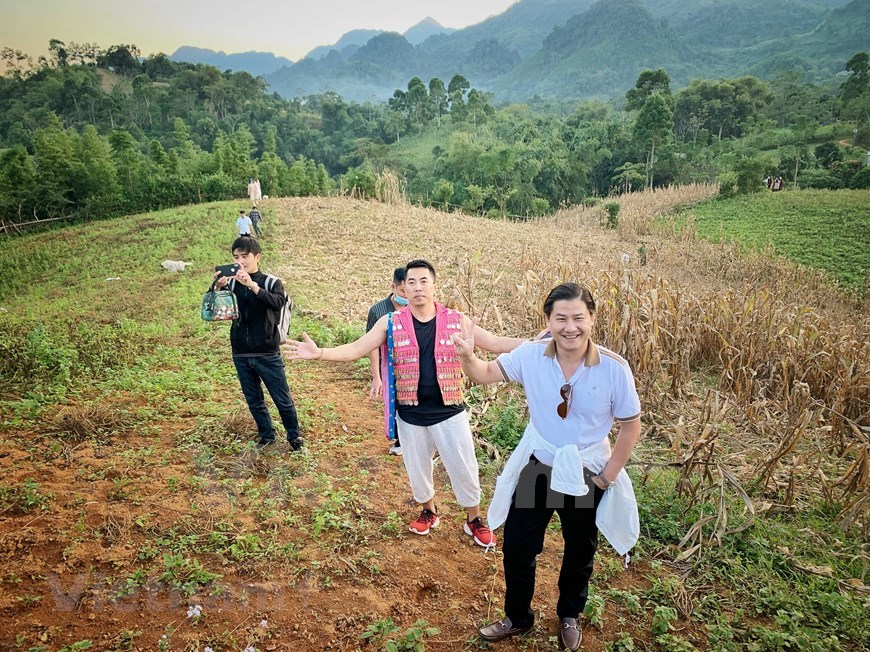
The next destination is Bakhan Village Resort, which is located in Ba Khan Valley of Son Thuy commune, Mai Chau district. Ba Khan Valley is currently a famous attraction among domestic and foreign tourists. It takes more than 2 hours to travel along National Highway 6 from Hanoi to reach Ba Khan valley. Located at the foot of Thung Khe Mountain Pass, which is covered by clouds all year round, this beautiful valley has become renowned only since 2019 because it is located between two famous tourist destinations, Mai Chau and Moc Chau. With wild scenery in an almost isolated location, this place can win over the heart of any visitors once they set foot here. (Photo: VietnamPlus)
-
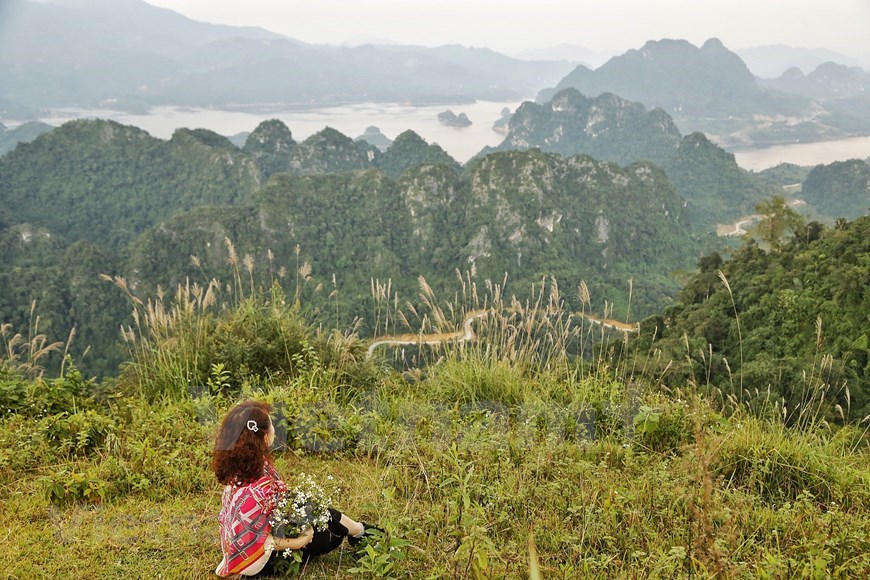
Covering 4 hectares of land, Bakhan Village Resort is located on a mountain slope which enables visitors to enjoy magnificent landscapes of Ba Khan Valley and Hoa Binh Lake. In particular, it features a boundless swimming pool that has become a favourite check-in destination for those who love to explore the mountainous northwestern region of Vietnam. According to the tourists who have chosen Ba Khan Valley as a stopover, travellers should not miss the dawn in the early morning when this area is blanketed in clouds. Besides, if they stay here and wait for the sunset, when the fog has gone away, the scenery appears with the undulating mountains reflected in the lake bed, making this place like a Ha Long Bay on land. (Photo: VietnamPlus)
-
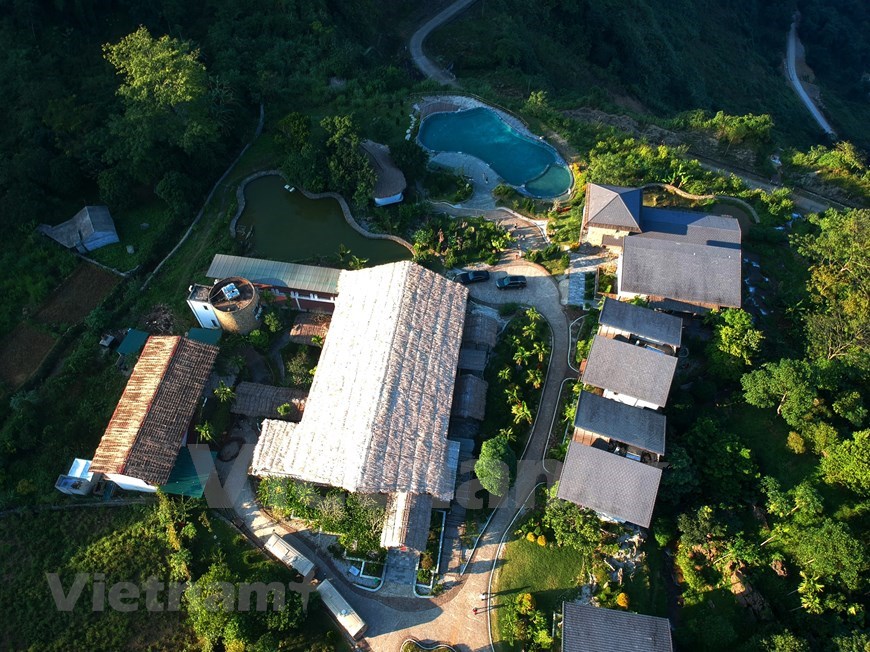
With modern design amid the nature, this resort is a fine combination of natural materials and contemporary elegance. It also has a restaurant serving traditional dishes of the northwestern region and European foods. From this resort, visitors can participate in various outdoor activities such as walking to visit nearby villages of ethnic minority people, trekking through primeval forests, kayaking, or sitting on boats on Hoa Binh Lake to visit caves. Ba Khan Valley is also an ideal place for groups of tourists to go picnicking, camping, and organise other activities. Visitors often bring along tents and camping tarpaulins for such trips. In addition, they can eat, sleep, stay at a homestay or contact a number of places welcoming travellers. (Photo: VietnamPlus)
-

Located at the foot of Thung Khe Mountain Pass covered by clouds all year round and between the two famous destination of Mai Chau and Moc Chau, this beautiful valley has just been known since 2019. In particular, with untouched scenery and an almost isolated location, Bakhan Village Resort can capture the heart of any travellers coming here. Ba Khan is one of the tourist destinations that Mai Chau district has been promoting and attracting the investment to. Ba Khan Valley welcomes visitors all year round, but it is busiest in summer, autumn and the New Year holidays, when a large number of people come here to enjoy unforgettable moments. (Photo: VietnamPlus)
-
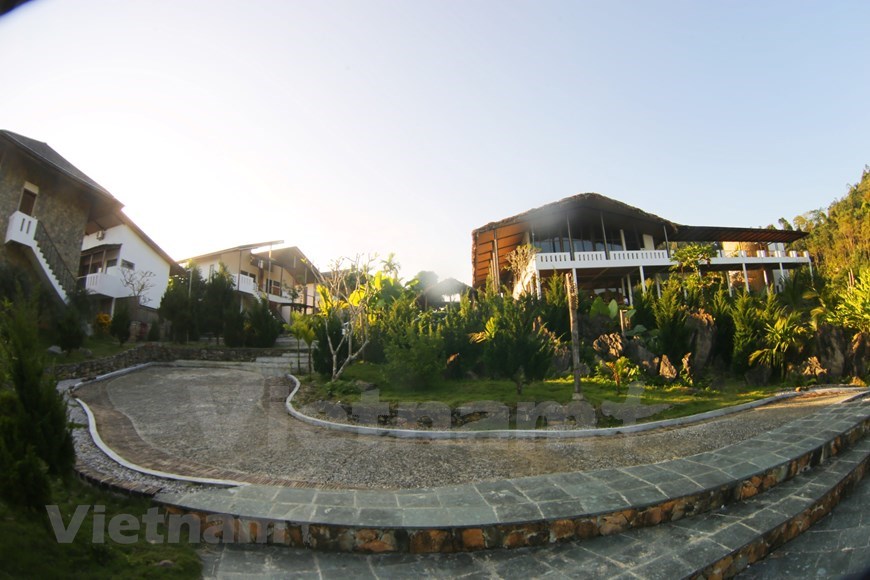
From Bakhan Village Resort, visitors can participate in various outdoor activities such as walking to visit nearby villages of ethnic minority people, trekking through primeval forests, kayaking, or sitting on boats on Hoa Binh Lake to visit caves. Looking from the top of Thung Khe Mountain Pass, Ba Khan Valley looks like a giant pan with rocks of all shapes and sizes emerging from the water surface. The whole scenery resembles a miniature Ha Long Bay. The path to the Ba Khan plain is the one-and-only route that reaches the hydroelectric reservoir through the town centre. Below Thung Khe Mountain Pass are villages where Thai ethnic people have resided for hundreds of years. (Photo: VietnamPlus)
-
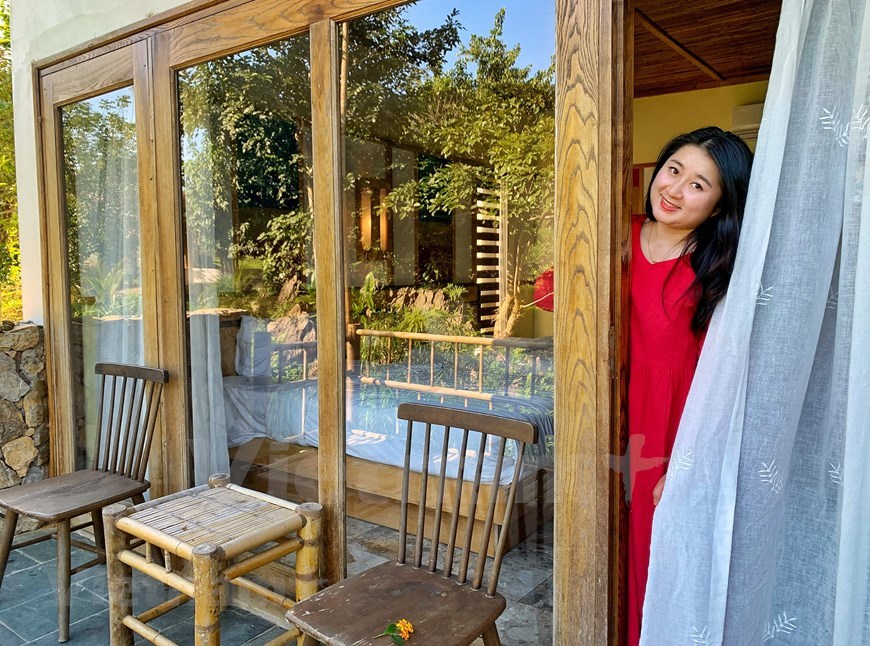
Here, travellers can enjoy the unforgettable sunrise and sunset views, breathtaking mountainous landscapes, as well as the fresh and cool air. Ba Khan consists of three villages: Khan Ha, Khan Ho and Khan Thuong. This valley is part of Mai Chau commune of Hoa Binh province, where Moc Chau is the centre of local tourism. Many experienced travellers and adventurers want to keep Ba Khan a secret to keep it a pristine paradise, free of the common tourist crowd for as long as possible. In the recent years, Ba Khan has been included in tourism itineraries offered by some family-run tourism businesses. The plain remains fairly untouched and undoubtedly well-preserved – fairly free from the commercialisation of the tourism industry. (Photo: VietnamPlus)
-
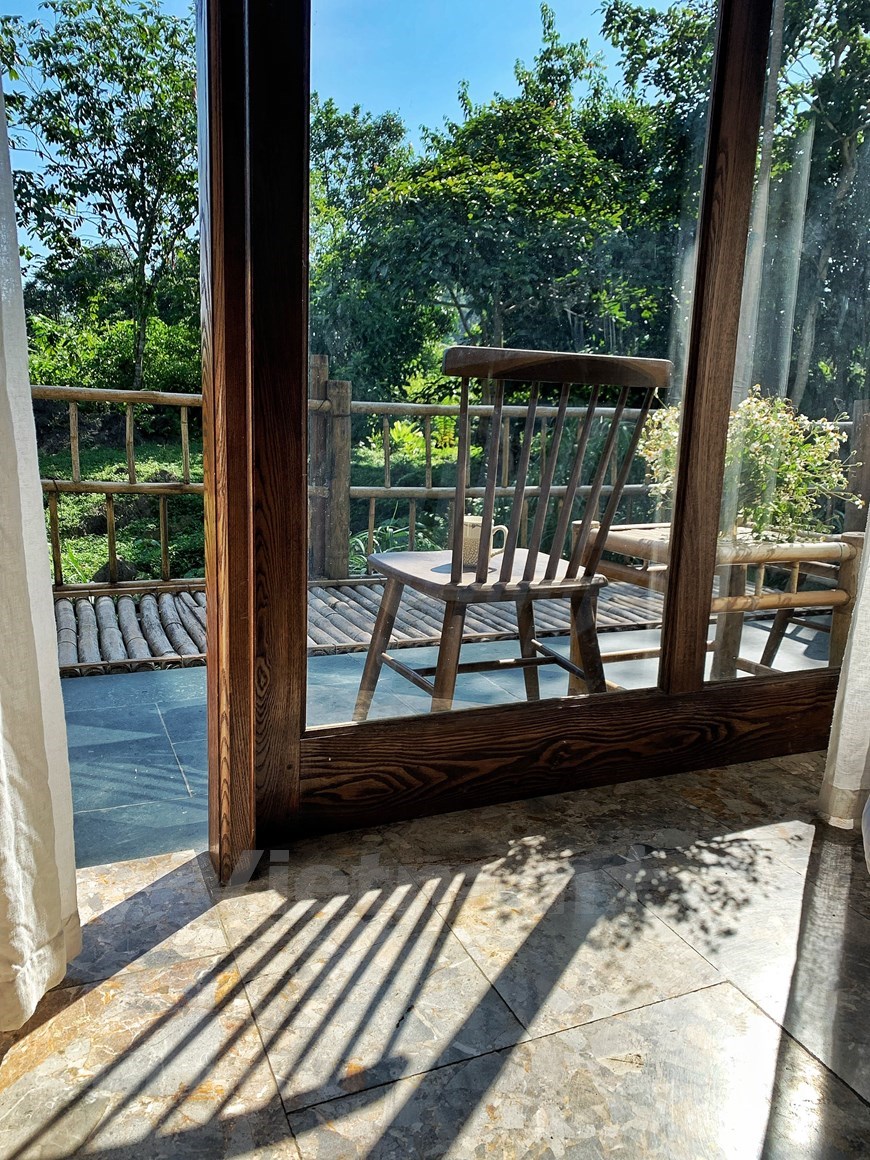
Resting in this resort, tourists can wake up in a fresh morning full of sunlight, the murmuring sound of a nearby stream, and the twitter of wild birds. Tourists can visit the valley at any time of the year, but Ba Khan is most beautiful in autumn, when the water in the Da River turns deep blue, and the bamboo bushes start shedding old leaves. One can visit Ba Khan in early summer to enjoy the view of the yellow ripe rice fields. It’s a perfect way to spend a hard-earned weekend: visiting Ba Khan Valley and relaxing in nearby villages. Given this, Ba Khan is considered the jewel of the drive from Hanoi to Mai Chau. (Photo: VietnamPlus)
-
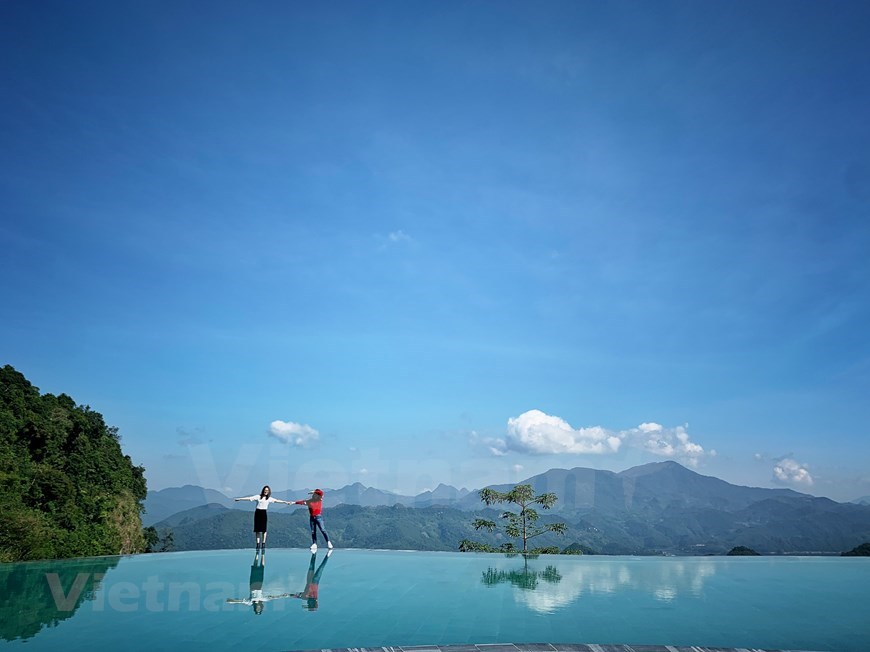
Travellers capture an unforgettable picture of themselves in the blue of the sky and the boundless swimming pool at Bakhan Village Resort. Hoa Binh Lake, a hydropower reservoir, is a relatively perfect combination of the nature and cultural identifies of local residents, and it has become a magnet for both tourists and investors. Covering an area of 2,249 square kilometres, the 70km-long lake spreads across many communes of five district-level localities in Hoa Binh province. Apart from the charming natural beauty, the lake also boasts a vast and unique cultural space of the Muong, Tay, Dao, and Thai ethnic minority groups that promises fresh experiences for tourists. (Photo: VietnamPlus)
-
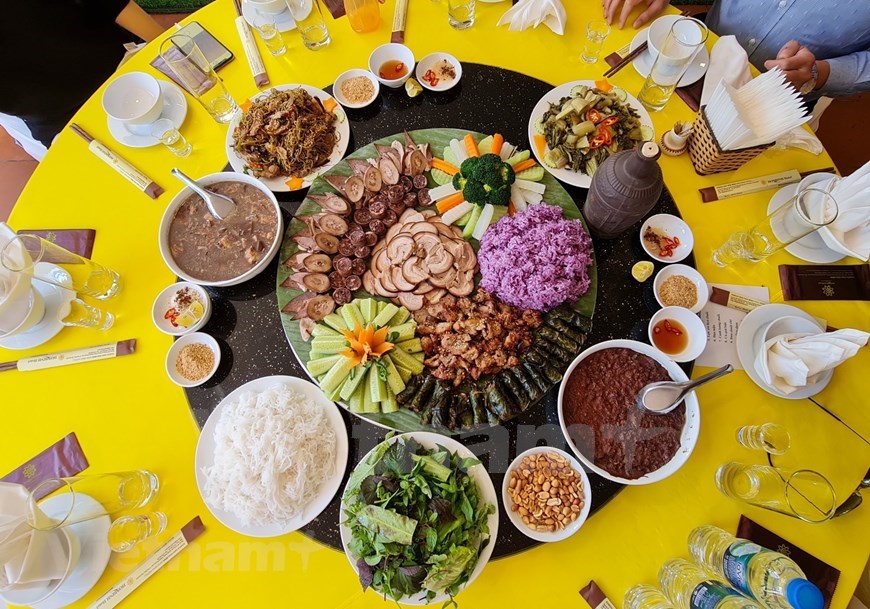
A meal full of local specialities is an ideal end for a trip to Hoa Binh province. Hoa Binh province is home to beautiful natural landscapes, from primeval forests, majestic caves, poetic lakes and waterfalls, terraced rice fields, and winding steep passes, as well as the unique culture of local ethnic minority groups. Local tourism potential has been “awakened” thanks to those advantages. Currently, the province has about 20 community-based tourism hamlets and villages. There are seven community tourism sites in Mai Chau district, four in Da Bac district, and three in Tan Lac district, among others. Through this type of tourism, visitors can understand more about the local tangible and intangible culture. (Photo: VietnamPlus)
Hoa Binh promises unique experiences of the land of Muong people
Hoa Binh is home to beautiful landscapes and special cultural identities of different ethnic groups, promising unique experiences for any visitors once setting foot in this mountainous province in the north of Vietnam

